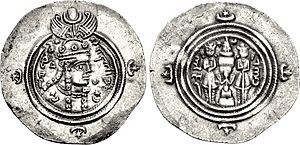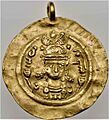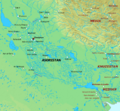Boran facts for kids
Quick facts for kids Boran |
|
|---|---|
| Queen of Queens of Iran | |

The only known gold dinar of Boran (Museum of Fine Arts, Boston)
|
|
| Queen of the Sasanian Empire | |
| 1st Reign | 630 |
| Predecessor | Shahrbaraz |
| Successor | Shapur-i Shahrvaraz |
| 2nd Reign | June 631 – June 632 |
| Predecessor | Azarmidokht |
| Successor | Yazdegerd III |
| Died | June 632 Ctesiphon |
| Spouse | Kavad II |
| House | House of Sasan |
| Father | Khosrow II |
| Mother | Maria |
| Religion | Zoroastrianism |
Boran (also called Pūrāndokht) was a powerful queen of the Sasanian Empire (ancient Iran) from 630 to 632 AD. She was the daughter of King Khosrow II, who ruled from 590 to 628 AD, and a Byzantine princess named Maria. Boran was only the second woman in Iranian history to rule as queen, following Musa of Parthia. Her sister, Azarmidokht, also ruled later.
Boran became queen during a very difficult time for the Sasanian Empire. Her father, Khosrow II, was overthrown and killed by her brother-husband Kavad II in 628 AD. Kavad II then had many of his brothers and half-brothers killed, which caused a lot of chaos and fighting within the empire. After Kavad II died, his young son Ardashir III became king, but he was soon killed by a military officer named Shahrbaraz. Boran then took the throne with the help of a strong military leader, Farrukh Hormizd. She and her sister were the only remaining royal family members who could rule. Boran wanted to bring back the glory of her father's reign, when the Sasanian Empire was at its largest.
Who Was Boran?
Boran was a queen of the Sasanian Empire, which was a powerful empire in ancient Iran. She ruled during a time of great trouble and civil war. Her main goal was to bring peace and order back to her country. She tried to do this by creating fair laws, rebuilding damaged areas, and lowering taxes. She also worked to improve relationships with the neighboring Byzantine Empire.
Boran's Family and Early Life
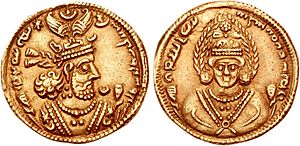
Boran was the daughter of Khosrow II, who was a very important king of Iran. Her mother was Maria, a princess from the Byzantine Empire. In 628 AD, Boran's father was overthrown and killed by his own son, Kavad II. Kavad II then ordered the killing of all of Boran's brothers and half-brothers. This was a terrible event that greatly weakened the empire.
Boran and her sister, Azarmidokht, were very upset by Kavad II's actions. Some historical texts say that Boran was also Kavad II's wife. This was a practice called Xwedodah, or close-kin marriage, which was part of the Zoroastrian religion.
After Khosrow II's death, the Sasanian Empire fell into a civil war. Powerful noble families, like the Persian (Parsig) and Parthian (Pahlav) groups, started fighting for control. A deadly disease, the Plague of Sheroe, also swept through the empire, killing many people, including Kavad II. His eight-year-old son, Ardashir III, became king.
However, Ardashir III's rule did not last long. In 630 AD, a general named Shahrbaraz killed him and took the throne. But Shahrbaraz himself was killed after only forty days. Then, Farrukh Hormizd, a leader of the Pahlav group, helped Boran become queen in June 630 AD. She was one of the few remaining members of the royal family who could rule.
Boran's First Reign
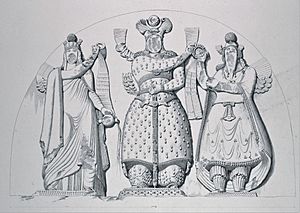
Boran was the first woman to rule the Sasanian Empire as queen. Before her, some royal women had held important political roles, but none had been the supreme ruler. People generally accepted her rule, and there was no major opposition because she was a woman. This might have been helped by stories of legendary queens and the respect for the Iranian goddess Anahita.
As queen, Boran appointed Farrukh Hormizd as her chief minister. She worked hard to bring stability to Iran. She introduced fair laws, began rebuilding damaged buildings and roads, and lowered taxes for her people. She also minted new coins, which showed her authority. Her rule was accepted in many parts of the empire, including Pars and Media.
However, her first reign was short. In 630 AD, she was removed from power. Shapur-i Shahrvaraz, a nephew of Khosrow II, became king. But he was not recognized by the Parsig faction and was quickly replaced by Boran's sister, Azarmidokht.
Boran's Second Reign
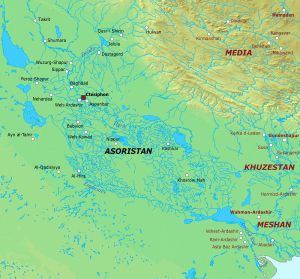
Farrukh Hormizd, who had helped Boran become queen, wanted to marry Azarmidokht to gain more power. Azarmidokht, however, had him killed with the help of another noble, Siyavakhsh.
Farrukh Hormizd's son, Rostam Farrokhzad, was very angry and wanted revenge for his father's death. He marched to Ctesiphon, the capital city, and defeated Siyavakhsh's forces. Rostam then had Azarmidokht killed and brought Boran back to the throne in June 631 AD.
During her second reign, Boran allowed Rostam to have most of the power, as the empire was in a very weak state. They made an agreement that Rostam would rule for ten years, and then power would return to the Sasanian royal family. Boran gathered the different noble groups, including the Parsig, and declared Rostam as the leader of the country and its army. The Parsig group agreed to work with the Pahlav group because Iran was in such a bad state.
Boran also wanted good relations with the Byzantine Empire. She sent a group of important people, including a church leader named Ishoyahb II, to meet with the Byzantine emperor Heraclius. Heraclius welcomed them warmly.
However, the cooperation between the noble groups did not last long. The Parsig group was unhappy with Rostam having so much power. In 632 AD, a revolt broke out in Ctesiphon. Boran was killed shortly after, likely by Piruz Khosrow, a leader of the Parsig faction.
After Boran's death, the fighting between the noble groups continued. Eventually, Rostam and Piruz Khosrow agreed to work together again. They placed Boran's nephew, Yazdegerd III, on the throne. He became the last Sasanian ruler, bringing an end to the civil war. Boran ruled for a total of about sixteen months during her two reigns. The Iranian dish called Borani might even be named after her!
Boran's Coins and Royal Ideas
When Boran became queen, she used coin designs similar to those of her father, Khosrow II. This showed her respect for him and her desire to bring back the glory of his time. On her coins, it was written that Boran was the "restorer of the race of Gods." This idea, that the ruler was descended from gods, had not been used by Sasanian kings since the 4th century.
Most of Boran's coins were silver drachms. She was also one of the few rulers during that chaotic period to mint bronze coins. Only one gold coin of Boran is known to exist today.
On her silver and bronze coins, Boran is shown looking to the right. On the back of the coins, there is a Zoroastrian fire altar with two attendants. Her gold coin shows her facing forward.
Boran's coins show her wearing a round cap with jewels and a diadem (a type of crown). Her braided hair falls from beneath her cap. Her crown also has feathered wings, which represent Verethragna, a Zoroastrian god of victory. There are also symbols of a crescent moon and a star on her crown and around her portrait, which were important astral signs.
Images for kids
-
The only known gold dinar of Boran (Museum of Fine Arts, Boston)
-
Gold dinar of Khosrow II
-
Mid-19th century drawing of rock reliefs at Taq-e Bostan, showing Boran's father Khosrow II, flanked by the goddess Anahita and the supreme deity Ahura Mazda (New York Public Library).
-
The southwestern part of the Sasanian Empire, where its capital of Ctesiphon, the residence of the monarch, was located.
See also
 In Spanish: Boran para niños
In Spanish: Boran para niños


